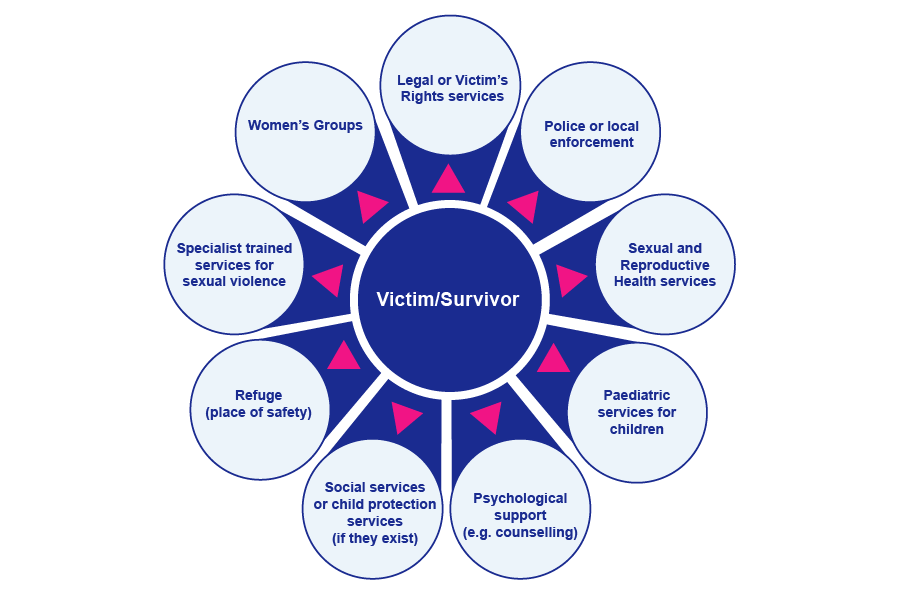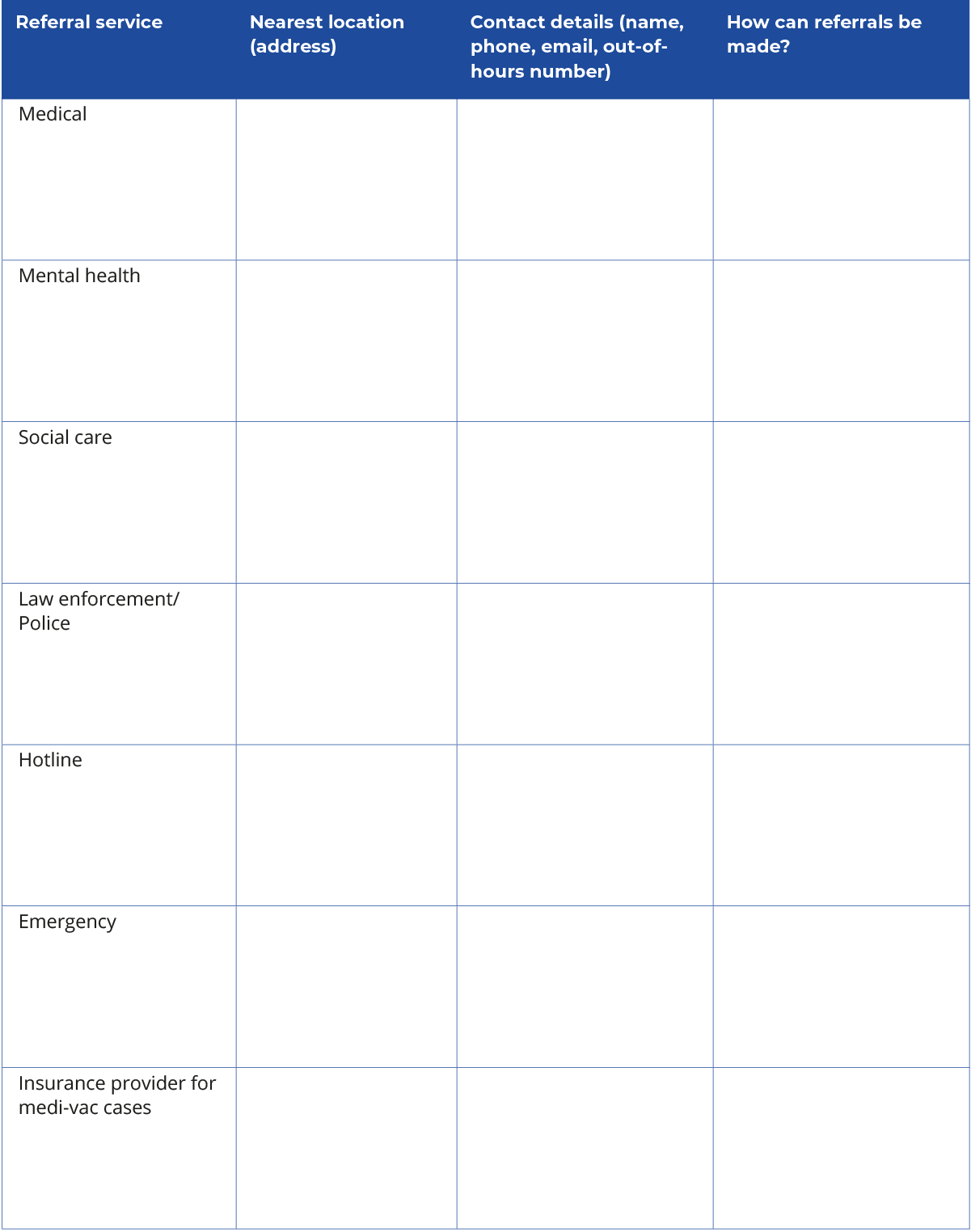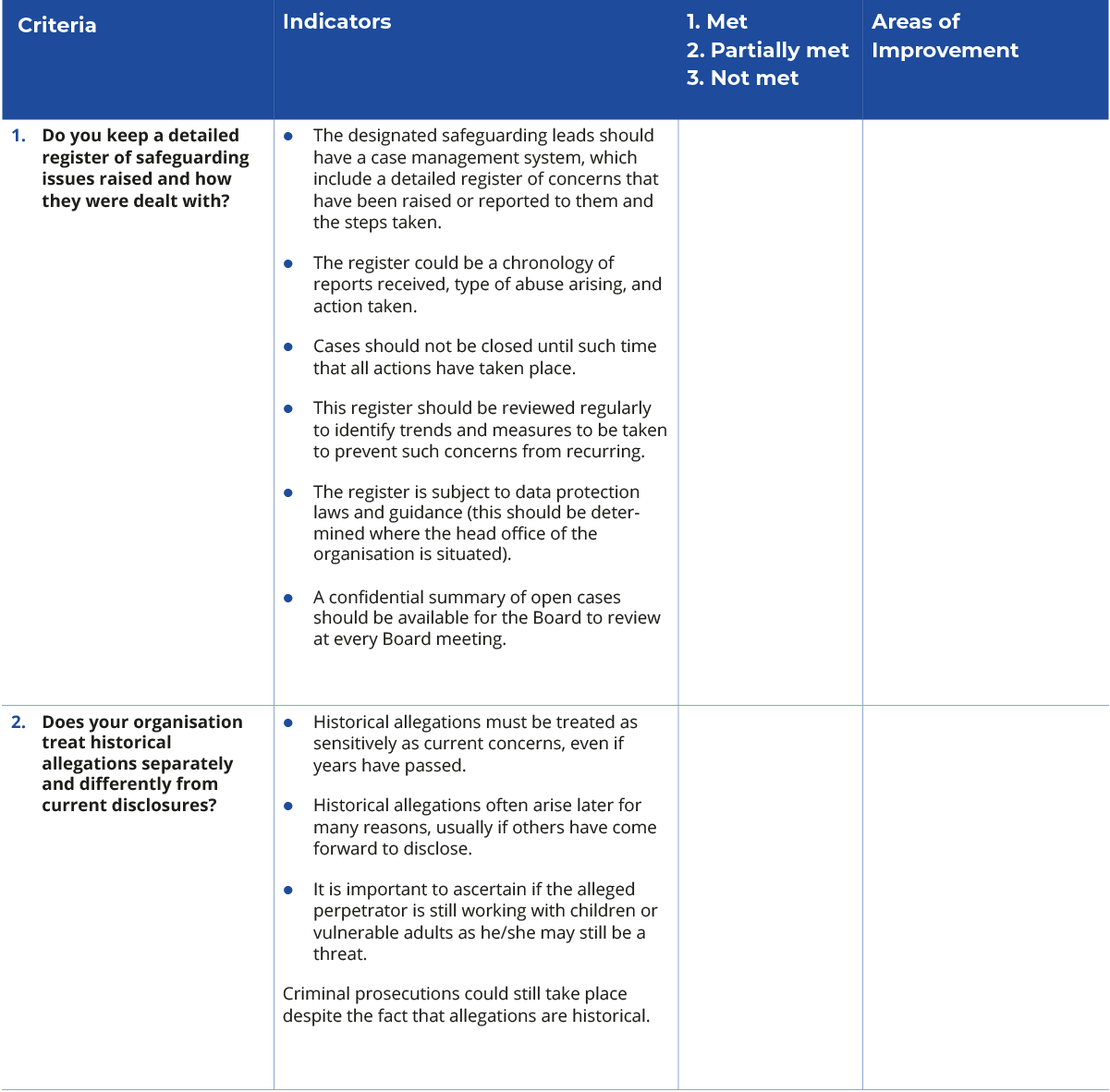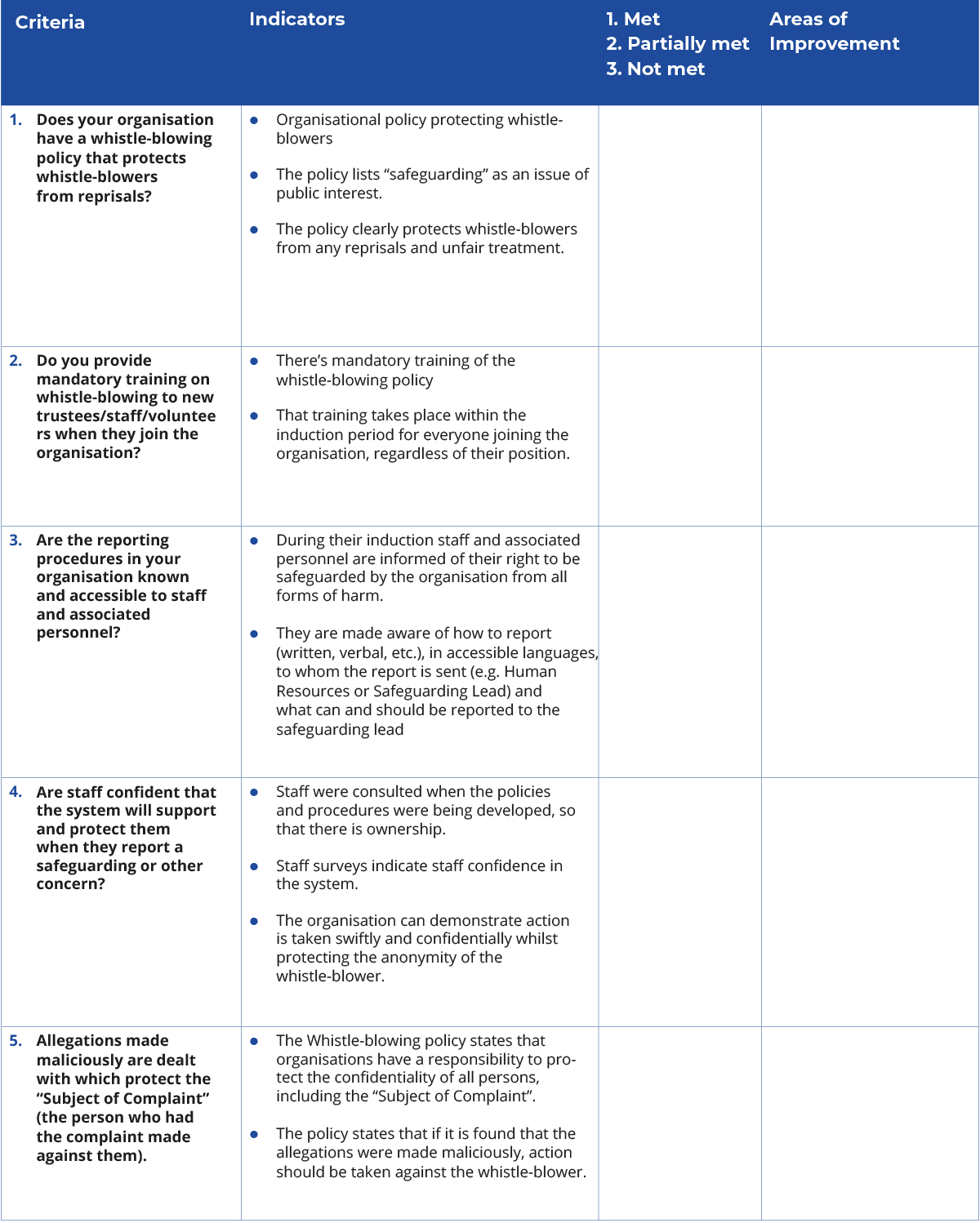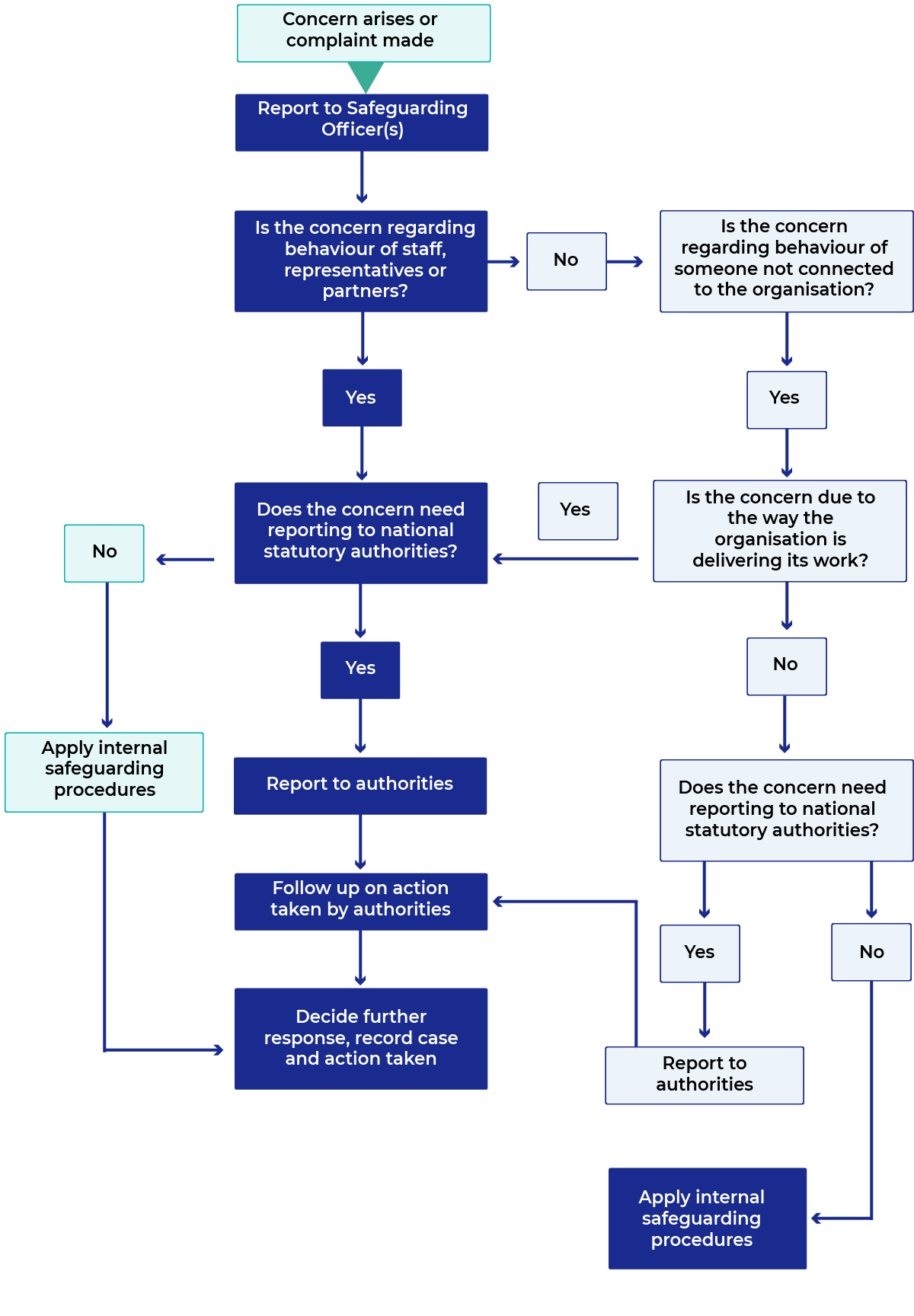Unit 5: Response
| Site: | OpenLearn Create |
| Course: | Introduction to Safeguarding in the International Aid Sector |
| Book: | Unit 5: Response |
| Printed by: | Guest user |
| Date: | Tuesday, 25 November 2025, 3:14 PM |
Table of contents
- The responding stage of the Safeguarding Cycle
- 5.1 Safeguarding concerns reported in the media
- 5.2 Reflect on lessons learnt
- 5.3 Managing disclosure
- 5.4 How to manage disclosure
- 5.5 The laws dealing with sexual abuse, exploitation and harassment
- 5.6 Developing referral pathways for safeguarding concerns
- 5.7 Locating available support services
- 5.8 Are your safeguarding procedures fit for purpose?
- 5.9 Supporting whistleblowers
- 5.10 Next steps
- 5.11 Record-keeping and data protection
- 5.12 Unit 5 Knowledge check
- 5.13 Review of Unit 5
The responding stage of the Safeguarding Cycle
Welcome to Unit 5 of this course. We return to the Safeguarding Cycle and look at how to respond to safeguarding concerns that are raised or reported.
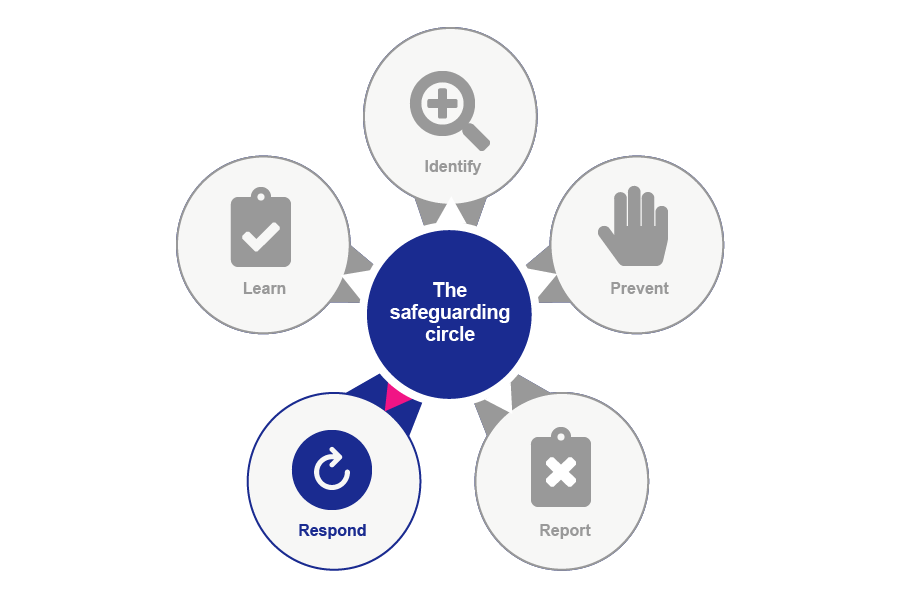
Once a report comes through, it’s important for organisations to know what to do next. These procedures should be documented clearly to prevent any further harm. In recent times, the media has highlighted how organisations have not responded appropriately when safeguarding concerns have been reported to them. Some organisations have focused on damage control and protecting their name and reputation rather than making decisions which are in the best interest of victims and survivors.
In this part of the course, we reflect on lessons learnt from some of the cases highlighted in the media. As a result of media exposure and public calls for greater accountability, institutional donors, research academies, financial institutions, the World Bank and the UN have taken a tougher stance to eradicate sexual misconduct in the international aid and development sector by including stringent compliance standards on the partners they fund so that the responsibility of safeguarding people is a priority throughout the delivery chain.
We look at the local legal context, managing disclosure, developing referral pathways and the importance of protecting whistleblowers.
5.1 Safeguarding concerns reported in the media

© Photo Kozyr / Shutterstock
In the following activities, you are encouraged to reflect on the causes and consequences of sexual exploitation, abuse and harassment allegedly committed by the staff of some international organisations in the international aid and development sector.
Reflect on how and why organisations reacted in the way that they did, why these responses were inappropriate and how can the lessons learnt be applicable to your organisation by strengthening your own response mechanisms.
|
Activity 5.1 Safeguarding scandals in the media Choose at least two real case studies from the list below. Follow the link, read the article, and then reflect and respond in your learning journal to the following questions:
(Note: these are journalist articles found in the media and have only been used here to raise issues for learning on this course. They are not necessarily endorsed by the course leaders.) |
5.2 Reflect on lessons learnt

© fon_napath / Shutterstock
|
Look back at your answers to the questions in the previous activity. What lessons can you learn for your own organisation to improve safeguarding? |
The case studies you have just examined provide important insights into how organisations might respond more effectively to safeguarding concerns, highlighting some of the causes and consequences of failure.
You will learn more about some of these points in greater detail as the course progresses, but it is worth highlighting a few key lessons learnt now:
- Safeguarding is not only about challenging the harmful behaviours of individuals but the attitudes, norms, power relationships and working cultures within organisations. This is often known as ‘organisational culture’.
- The needs of victims and whistleblowers should always be prioritised over the reputational consequences for the organisation. This is known as taking a ‘survivor-centred approach’.
- Organisations should respond effectively and transparently to safeguarding concerns and uphold appropriate standards.
- Organisations have a responsibility to share information with appropriate authorities, taking a risk-based approach to survivors.
5.3 Managing disclosure
As you have already learnt in Unit 4, for a child, vulnerable adult or staff member to disclose that they do not feel safe because of other’s inappropriate behaviour is very difficult for them, and so it is vital to make sure that we respond in the right way.
People may disclose safeguarding concerns in a variety of ways, including:
- Directly – making specific verbal or written reports about what’s happened.
- Indirectly – making ambiguous verbal or written statements which suggest someone feels unsafe (for example, social media posts, drawing pictures).
- Behaviourally – displaying a change of behaviour that is uncharacteristic of them or concerning or behaviour of another which is concerning and inappropriate or they may display signs and symptoms (covered in Week Unit 2 of this course).
|
Activity 5.2 How to respond when a child discloses abuse For a child, vulnerable adult or staff member to disclose that they do not feel safe is usually very difficult for them and so it is vital we respond in the right way. Watch the video animation above that shows you how to respond when a child tells you about experiencing abuse and then reflect on the questions that follow. Reflect and respond in your learning journal:
|
5.4 How to manage disclosure
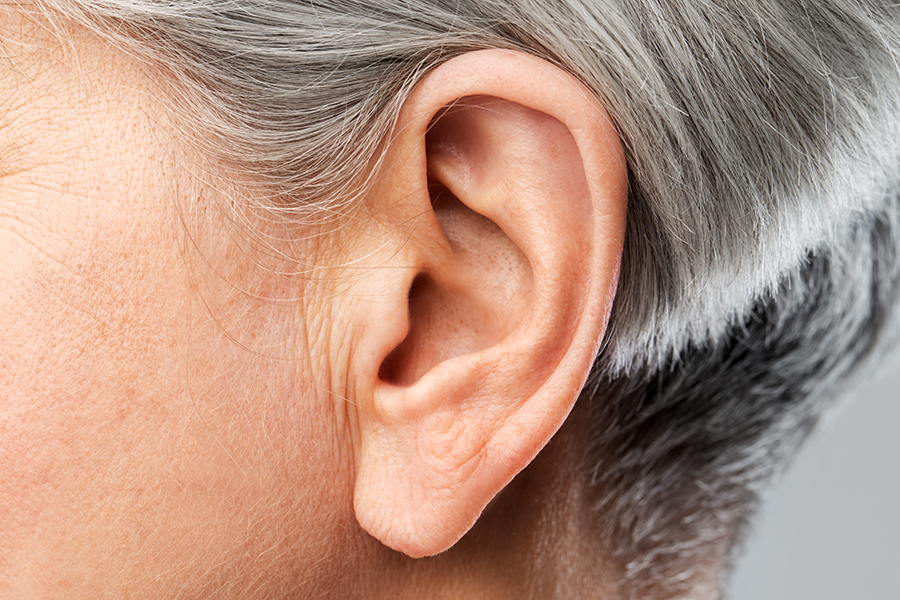
© Syda Productions / Shutterstock
A key skill when managing disclosure is active listening. This makes those who are disclosing feel they are being listened to and are being taken seriously.
Active listening requires listeners to:
- Show you care, help them open up.
- Give your full attention and keep your body language open and encouraging.
- Be compassionate, be understanding and reassure them their feelings are important.
- Use phrases such as ‘this is not your fault’ or ‘you are so brave’ to help reassure them.
- Respect pauses and don’t interrupt – let them go at their own pace.
- Repeat back what they’ve said to check your understanding – and use their words to validate their experience.
- Use open questions, for example, ‘what happened next?’ Do not put words into their mouth.
Ensure that the disclosure is taking place in a confidential place where the person disclosing feels safe. Keep confidentiality and only disclose information to those who need to know (e.g., the Designated Safeguarding Officer).
It is good practice to write notes during this meeting of what the person is saying or as soon as it is over while your memory is still fresh. Make a note of their body language or any signs and symptoms. Do not include your opinion in your report.
Do not:
- Pre-judge the situation.
- Disregard the situation or deny what is being said.
- Show annoyance, anger or disapproval.
- Make promises which you may not be able to keep, for example, don’t promise to keep secrets when you know that you have a duty to report the matter to prevent further harm. Therefore, inform the person that you will need to report the matter further with their permission (if they are an adult) and based on any risks to their safety.
- Contact or confront the alleged perpetrator on your own (more about this later).
- Interview the person several times – this might reinforce to the person that they are not being believed.
We would emphasise here that only those who have had training and expertise should interview children or adults with disabilities as this requires professional skill.
This may include trained social workers, police officers, psychologists and paediatricians.
Safeguarding leads need to carefully consider how to manage disclosure so that survivors are not re-traumatised by the experience. For example, such interviews should take place with a trusted adult (of the survivor’s choosing) in the room to support them.
Before you move on to the next section, based on the information you have seen on managing disclosure, consider what action you could take to ensure that this good practice is included in your organisational safeguarding procedures.
![]()
Want to find out more?
This Safeguarding VR activity provides an opportunity to put yourself in the position of the person managing disclosure of sexual abuse.
5.5 The laws dealing with sexual abuse, exploitation and harassment
It is important to understand the laws of your work location in relation to dealing with sexual exploitation, abuse and harassment (SEAH) so that you’re better prepared to deal with these.
This will also be important when you may need to advise victims/survivors of their rights.
There are also rights and responsibilities owed to the perpetrators under Employment Law, which you may have to get legal advice on.
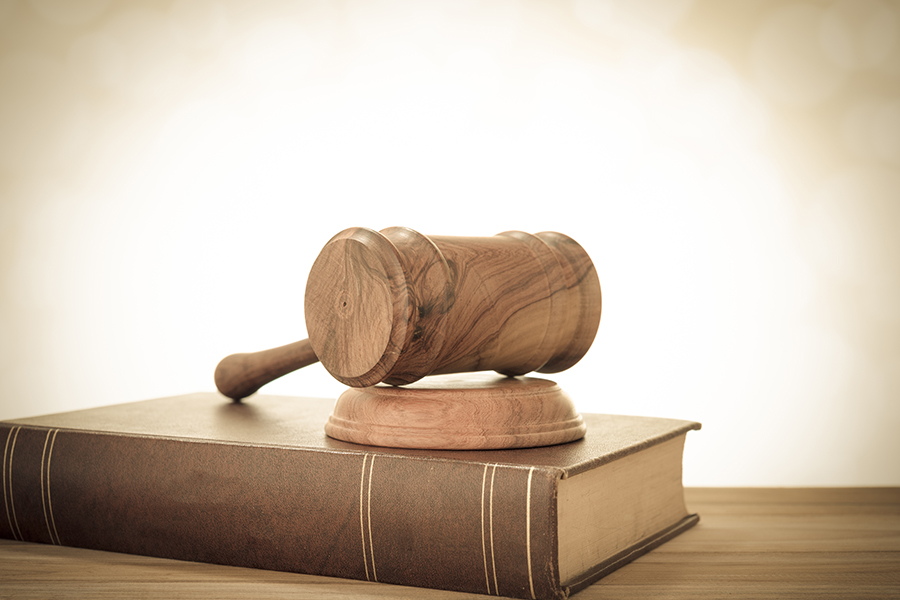
© create jobs 51 / Shutterstock
As part of your mapping of what is available in the areas that your organisation is working in, it is important to have some idea of the laws of that location in relation to dealing with sexual abuse, exploitation and harassment.
|
Activity 5.3 What are the laws in your location? You might already know the answers to the questions below or, at this point, you might need to do some further research. Make a note of your answers in your learning journal.
|
Definitions of children under local laws
![]()
Sherine has a question relating the various definitions of children under local laws.
Watch the video above to find out more.
|
Is the definition of a child as being anyone under the age of 18 (UN Convention on the Rights of the Child, 1989 or other) followed in the country that you work in? |
5.6 Developing referral pathways for safeguarding concerns
A ‘referral pathway’ includes identifying, tracking, referring and following up with safeguarding concerns after they are disclosed and reported.
When managing disclosures, you may have to support victims, survivors or witnesses of safeguarding concerns to access professional help and assistance. They have a right to these services, and we have a responsibility to ensure they have the information and support to do so.
In this part of the course, you will think about the different kinds of professional services required by victims depending on their needs and circumstances. You will identify and map support services in the area that your organisational projects, programmes and offices are located and think about what you might need to consider when engaging them.
|
Activity 5.4 What referral services are required? When dealing with victims, survivors and witnesses, what professional services do you think they would require? Think about their physical, sexual and reproductive health, and their emotional, psychological and social needs if they have suffered violence and/or trauma. Make a list of as many services as you can think of in your learning journal. Ask your colleagues if you are unsure of any gaps. Study the diagram below for some suggestions. It is an example of mapping of possible referral services – victims/survivors may not require all the services listed, it will depend on their needs and their consent. Also, not all services may be available in your organisational geographical location.
|
How to make referrals to support services
|
Activity 5.5 Accessing support services for gender-based violence
Watch the video above, which is about accessing support services for gender-based violence in humanitarian response settings. When you have watched the video, answer the following questions in your learning journal:
Make a note of your answers in your learning journal so that you can refer to it later when developing your organisation’s referral pathway. |
5.7 Locating available support services

© Marian Salabai / Shutterstock.com
|
Activity 5.6 Mapping referral services This is an opportunity for you to map the geographical location of referral services in the geographical location of your organisation’s projects or programmes. You will need the following:
Research where the nearest referral services are to your office and/or project sites:
Based on the map, indicate the physical location of these referral services with the different coloured dots or coloured pens (use a different colour for a different service). For example:
If you are based in the head office, map the locations of referral services for your geographical area. If you have identified safeguarding focal points in the project locations, ask them to map the referral services in their area as well to ensure you have a complete list if required. |
How to refer to support services
Now that you have a good idea of what services are required and where they are located, it is important to think about how a Designated Safeguarding Lead or Safeguarding Focal Point should make referrals.
|
Activity 5.7 Referral service checklist Fill in the columns on the table below (here is a downloadable version of this). You should already have the information for the first two columns from the previous activity. In the third column you need to note how you make referrals.
© (Source: Aneeta Williams/The Open University) |
5.8 Are your safeguarding procedures fit for purpose?
As mentioned before, it is important that your organisational safeguarding policy and procedures describe what next steps should be taken by organisations.
This will help guide an appropriate response that is survivor-centred and appropriate. It’s not good enough to make it up as you go along.
|
Activity 5.8 Study the example table below. Here is a downloadable version of this table. Column 1 – is a list of criteria for safeguarding under donor compliance standards. Column 2 – are the indicators which satisfy the criterion. Column 3 – has been left blank for you to complete on behalf of your organisation.
Column 4 – for those columns which have been shaded orange or red, make a note of the various areas which can be improved in your organisation.
(Adapted from FCDO’s Enhanced Due Diligence Standards. Reproduced under the terms of the OGL) |
5.9 Supporting whistleblowers

© Andrii Yalanskyi / Shutterstock
You will remember from Unit 4 that some people are hesitant to come forward to report their concerns for various reasons. Often, they are afraid of a backlash by organisations.
Many of those who report may not be survivors or victims themselves but are known as ‘whistleblowers’, i.e., they are disclosing concerns that they believe are in the public interest and will affect others.
A whistleblower is a person, usually an employee, who exposes information or activity within a private, public, or government organisation that they believe to be illegal, illicit, unsafe, a waste, fraudulent or an abuse of taxpayer funds. Those who become whistleblowers can choose to bring information or allegations to surface either internally or externally.
It’s important therefore to understand the fears of those who do speak up and consider organisational responsibility to protect them.
|
Activity 5.9 Potential consequences of speaking out Read the following account of Bao who was a field worker with an NGO. The experiences he describes highlight the potential consequences of speaking out for individual workers. Bao: “I kept quiet for a time, but I didn’t like the way this member of staff was behaving with some of the children. So, in the end, I decided I had to speak up. When I did, it seemed like nobody believed me and everybody, including the management, made my life difficult. People stopped talking to me and I started getting threatening letters delivered to my home. I had to leave the organisation in the end and not much action has been taken about the concerns I raised anyway – they just moved that guy on quietly. I’m so disappointed in the organisation, which I thought was supposed to be helping vulnerable people and keeping them safe.” Reflect and respond to these questions in your learning journal:
|
Whistleblowers and safeguarding
![]()
Hasan has a question about whistleblowing. Watch the video above.
|
Activity 5.10 Checklist on whistleblower protection
Based on international donor standards, organisational safeguarding policies and procedures must contain protection for whistleblowers against any repercussions of speaking out. Study the example table below. Here is a downloadable version of this table. Column 1 – is a list of criteria for whistleblowing under donor compliance standards. Column 2 – are the indicators which satisfy the criterion. Column 3 – has been left blank for you to complete on behalf of your organisation.
Column 4 – for those columns which have been shaded orange or red, make a note of the various areas which can be improved in your organisation. Also think about what you will need to do to make these improvements a reality.
© (Adapted from FCDO’s Enhanced Due Diligence Standards. Reproduced under the terms of the OGL) |
![]()
Want to find out more?
If you are interested in reading more on whistleblowing, follow the links below:
5.10 Next steps
What are the next steps to be taken by the organisation once a complaint is received? We have explored how to respond to a disclosure from a child and vulnerable adult. As a Safeguarding Lead, you will need to know what next steps to take if you are satisfied that the concern warrants further action.
|
Activity 5.11 Steps to take when a complaint is received Click on the interactive link below. You will be asked to place a list of statements in the order in which the series of events should happen (chronological order). The term ‘safeguarding committee’ is used in this exercise. This term is often used to describe an internal group of people who may receive the safeguarding reports and decide how the organisation will respond. The committee could include the Safeguarding Lead, the Designated Safeguarding Board member and one or two senior leaders. If you cannot activate this interactive for any reason (e.g., browser issues or accessibility), here is a downloadable PDF version of the task and the model answer. |
|
Activity 5.12 How INGOs are responding to reported safeguarding concerns Watch this video on the experience of how INGOs are responding to reported safeguarding concerns. |
|
Reflect on the key learning points and messages from the video you’ve just watched. |
5.11 Record-keeping and data protection

You looked earlier at the start of the reporting process, i.e., making careful notes of the safeguarding concerns you have been alerted to, but it is important to think through the whole process of what happens to the information that you record, both at that point and also as an investigation progresses.
- Confidentiality – it is important to keep the information you have recorded confidential. This requires both an adequate system for case management, storage of information and an understanding of which information needs to be passed on and to whom. Confidentiality is most important throughout managing the safeguarding concern and beyond.
- Reporting procedures – be clear about the reporting procedures beyond dealing with the initial incidents. For example, serious incidents where there has been significant harm to the victim(s) and/or there has been a breach of the Code of Conduct, these will need to be reported to the Designated Safeguarding Board member and anonymised for reporting to the Board. Also, organisations will need to report serious concerns to donors as per the terms of their contractual agreements and any data protection laws.
- Data protection – is now a big issue not just within organisations but is often prescribed by law. It is important to know if there are laws that relate to your own setting as they must be complied with. If there are no specific laws that apply, you need to be aware of international standards.
- Using data for learning – anonymised information on serious incidents and how they were handled is useful for ongoing learning and development.
|
Activity 5.13 Recording systems and data storage Reflect and respond in your learning journal to the following questions in relation to your own organisation:
Overview It is good practice to develop a simple flowchart to demonstrate the next steps that we’ve been discussing in this unit. This flow diagram can be added to your safeguarding procedures as well as being displayed prominently for staff and beneficiaries to understand what they can expect if they raise a safeguarding concern. Using the template below as an example, check the existing reporting and response procedures of your organisation. If one doesn’t exist, then use the template to help design one for your organisation. Think about the various ways and means the safeguarding concern was reported, how they are received, who received them, how they should be dealt with and within what time scale. Then think of next steps that need to be taken.
© (Adapted from Save the Children’s Resource Centre Keeping Children Safe: A Toolkit for Child Protection)
Here is a downloadable version of this flow diagram. Notes to remember:
Note that whilst the local authorities investigate the matter, the organisation should not carry out a parallel internal investigation which may taint the evidence of witnesses or documents. If the local authorities decide not to investigate, the organisation should carry out their own internal investigations into the allegations made. |
5.12 Unit 5 Knowledge check
The end-of-unit knowledge check is a great way to check your understanding of what you have learnt.
There are five questions, and you can have up to 3 attempts at each question depending on the question type. The quizzes at the end of each unit count towards achieving your Digital Badge for the course. You must score at least 80% in each quiz to achieve the Statement of Participation and Digital Badge.
5.13 Review of Unit 5

© Feodora Chiosea / iStock / Getty Images Plus.
Congratulations on reaching the end of Unit 5!
You began by revisiting the safeguarding cycle and thinking about the importance of responding to safeguarding concerns that were reported. You considered the lessons learnt from real case studies and reflected on how response mechanisms could be improved in your organisation.
You studied how to respond appropriately to disclosures and how to take a survivor-centred approach by mapping referral services. You also looked at protection for whistleblowers and all those included in the safeguarding concern.
You developed a confidential response mechanism for your organisation and learnt about your responsibilities to complainants with an emphasis on the importance of confidentiality.
|
Reflect and respond to these questions in your learning journal:
For the final part of this course, we will be looking at monitoring and evaluating your safeguarding systems in place and the importance of incorporating lessons learnt. To help you prepare, consider the following question:
|
Now go to Unit 6: Learning and implementation.
